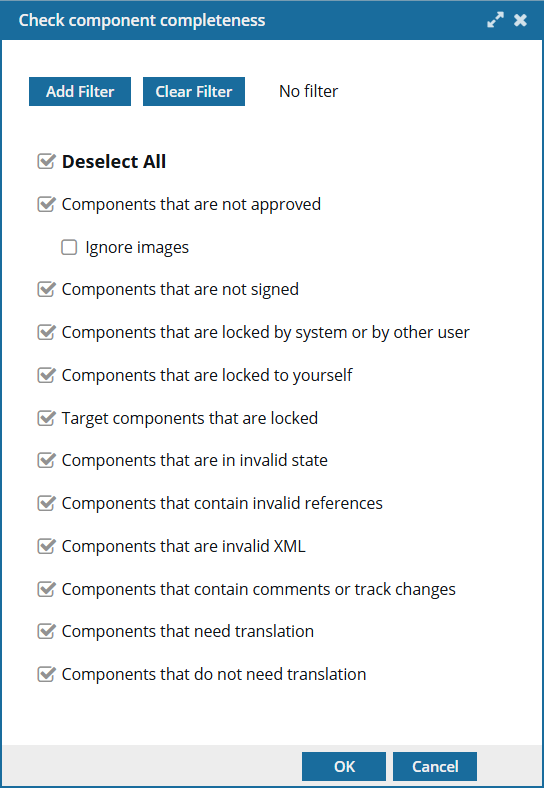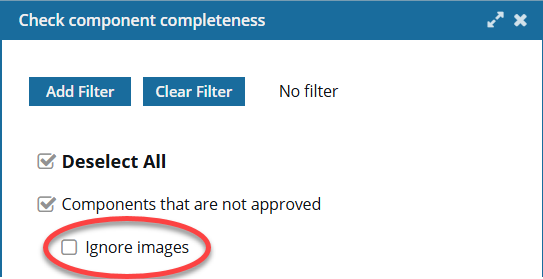Check component completeness
Before you publish a component or send it for translation, you can view a report to see if there are any errors or problems. By default, the completeness report checks for the filtering of conditional text, approval state, electronic signatures, lock state, an invalid state, invalid XML, and whether there are comments or track changes in the component. Additionally, if a component has been sent to translation, Inspire can check to see if the translation has been completed or if it still needs to be translated (the job is in progress). You can view your report from the notification sent when the verification checks are complete.
 A content owner or administrator can set permissions to deny access to components or folders. If your permissions to content have been blocked and you are not an administrator, you cannot use the Completeness Report option in a project's Content pane.
A content owner or administrator can set permissions to deny access to components or folders. If your permissions to content have been blocked and you are not an administrator, you cannot use the Completeness Report option in a project's Content pane.

 Tips and tricks
Tips and tricks
- You can't run a completeness check on the following types of components:
- Binary
- Workflow
- You can run a completeness check on multiple components at once from the Components Browser.
 In a project, you can't select multiple components at once to run a completeness report.
In a project, you can't select multiple components at once to run a completeness report. - You can run a completeness report on a map to see details for all topic references in the map.

 You can quickly clear all report options and choose only the few you need using the Deselect All option.
You can quickly clear all report options and choose only the few you need using the Deselect All option.
- By default, all report options are selected.
- After you click Deselect All and choose only the report options you need, Inspire remembers your selections. The next time you select the Completeness Report option for any component, only the options you chose previously are selected by default. If you want to return to the default of having all report options selected, clear your browser cache.

Filters
If you want the report to include certain text that you've marked in a component as conditional using profiling attributes, you can use the Add Filter button to select the attributes.
For example,
- In the selected component, you only want to include the text you've tagged with Audience = Advanced.
- You want to skip the text you tagged with Audience = Beginner.
- You can Add a filter and select the Audience category and the Advanced attribute.
- You can see any filters you've applied listed under Add Filter.
For more information about using filters, read Create a filter for profiling attributes in Oxygen.

Approval
 By default, when you create a new component Inspire assigns it a state of Not Approved. The pencil icon shown before the component name in the browser indicates it's in draft form.
By default, when you create a new component Inspire assigns it a state of Not Approved. The pencil icon shown before the component name in the browser indicates it's in draft form.
 You can approve a component when it's ready to publish or translate, and the icon changes to a green checkmark.
You can approve a component when it's ready to publish or translate, and the icon changes to a green checkmark.
Keep in mind that the approval state doesn't prevent you from using the component in a project, review, translation, or workflow. To learn more, read Approve or unapprove a component.

 You can exclude images when checking for approved components. This option is not available for any other category except for Components that are not approved.
You can exclude images when checking for approved components. This option is not available for any other category except for Components that are not approved.

Signatures
When you approve a component, if an electronic signature is required, then you must attach your electronic signature. If you want to check if any components don't have an electronic signature, select this option.
- When you approve a component, if an electronic signature is required, then you see
 the electronic signature icon in the Components browser.
the electronic signature icon in the Components browser. - When you approve a component, if an electronic signature isn't required, then you see
 the check mark icon in the Components browser.
the check mark icon in the Components browser.
For more information about requiring an electronic signature upon approval, read Approve or unapprove a component.

Lock State
Components that are locked indicate a user has the component open for editing or has made changes and hasn't submitted them yet. For steps on how to unlock a component, read Save your work in Oxygen.
 The system has the component locked because it's being used in a review, translation, or an editing session.
The system has the component locked because it's being used in a review, translation, or an editing session.
 The component has been approved and locked.
The component has been approved and locked.
 Another user has the component locked.
Another user has the component locked.
 You have the component locked.
You have the component locked.
 All changes to the component have been saved and it can be opened for editing, publishing, or translating.
All changes to the component have been saved and it can be opened for editing, publishing, or translating.
Now you can also check to see if any translated files returned from the vendor are locked. When creating the Completeness Report, select the option: Target components that are locked.

State
 There are two problems that can cause a component to have an invalid state and display a warning icon before the component name:
There are two problems that can cause a component to have an invalid state and display a warning icon before the component name:
- Invalid relationships. This means that a component has a problem with its references to other components. Relationship configurations can incorporate XML link types, attributes, and elements. To correct this issue, read Repair an invalid component relationship.
- Invalid XML + binary. A component has invalid XML and it was imported as binary. To correct this issue, edit the binary in the application that created it to fix the XML errors and then re-import it into Inspire.

References
Inspire checks the component's XML for invalid relationships (links to conrefs, xrefs, topicrefs, etc.) Inspire looks for broken references regardless of the component's state. To correct this issue, read Repair an invalid component relationship.

XML
Inspire checks a component to confirm that it is both well-formed and valid. A well-formed document follows the basic syntactic rules of XML, which are the same for all XML documents. The XML is valid if it follows a defined structure.
There is no icon before the component name in the browser if there's a problem with the XML code. To know if there are problems, open the component in the Oxygen editor. The right panel contains a Validation pane that tells you if the XML is valid, lists any errors, and gives you suggestions on how to correct them. You'll also see a red line in the actual content warning you of the XML validation error. To learn more, read Check for errors in the Validation pane.

Comments and Track Changes
Unless you want to publish a component with comments and track changes for external review purposes, you can make sure a component doesn't contain any of these artifacts. This is especially important to check before sending a component to translation.
You can open a component for editing if it isn't locked and remove the comments and accept or reject the changes. For help resolving comments and changes in a review, read Resolve a review.

Translation
You can confirm if components have been translated for a language. By running a completeness report and selecting the following options, you can see if one or more components need translation:
- Components that need translation. If a component has been sent to translation, Inspire can check to see if the translation has not been completed yet (the job is in progress).
- Components that don't need translation. If a component has been sent to translation, Inspire can check to see if the translation has been completed.
If there are components in one of these states, you can use the link on the name to open the component for editing, or use the filename link in parenthesis to open the Components browser and see the file in it's saved location. If there aren't any components that meet the criteria, the section title displays with the text No components match this criteria.
 If you select a component that has been sent to translation and run a completeness report on it, the report lists all locked translation files for the selected component and all referenced components.
If you select a component that has been sent to translation and run a completeness report on it, the report lists all locked translation files for the selected component and all referenced components.